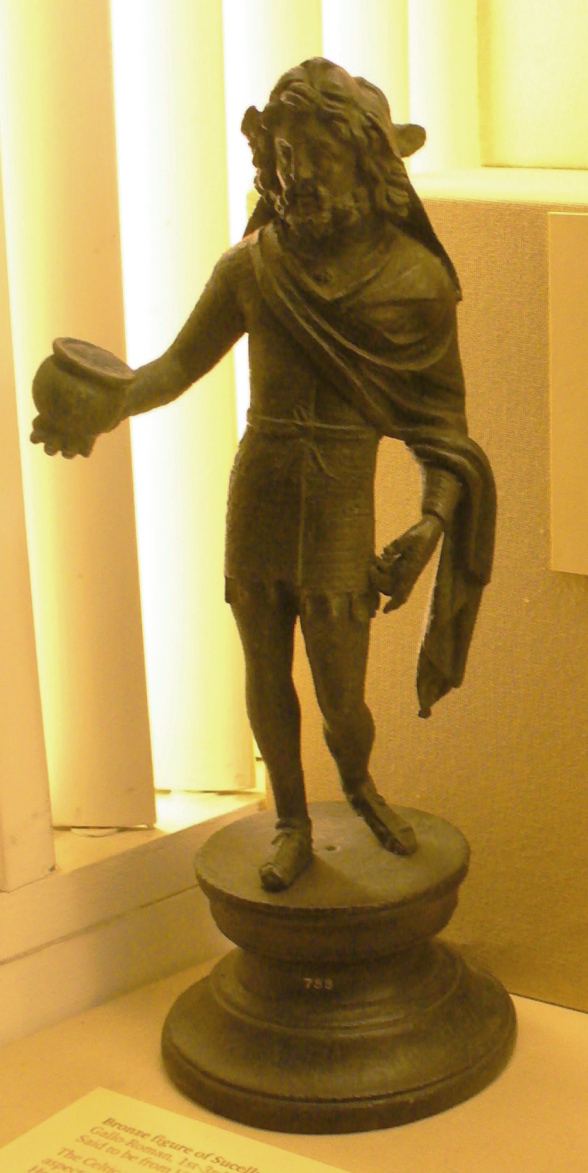
A bronze statuette of Sucellus, depicted as a mature, bearded man with a benevolent visage. He has simple peasant clothes; on his head he here wears a lion’s skin, like Hercules, emphasizing his role as protector of the countryside.
(British Museum)

Sucellus Silvanus is a humble god. He was above all a god of peasants and slaves, of people who had neither the money nor the prestige to offer him magnificent monuments.[1] His importance, therefore, like that of Venus, the Mother Goddesses, or Epona, is much greater than the number of inscriptions or temples dedicated to him might suggest. He protects the areas that lie at the margins of society—woods and wild places—but also fields and vineyards. Many inscriptions in his honour have been found near mines and quarries.[2] In fine, he guarantees the protection and prosperity of the working class at large.
Before we go into more detail, we must recognize the complexity of our subject. The Gaulish Silvanus is born of a fusion between two gods who must originally have been distinct: the Italian Silvanus, and the Celtic Sucellus. Both these names are conjoined in an inscription from Worms;[3] in the South of France, the name Silvanus is used almost exclusively; elsewhere, both names either coexist, or the god is all but absent. We first shall introduce the Italian Silvanus, and then speak further of the Gaulish Sucellus and Silvanus.
“Blest ... is he who knows the rural gods, / Pan, old Silvanus, and the sister-nymphs!”
—Virgil[4]
In Italy, Silvanus protects both forests and fields. He presides in particular over the boundaries of properties; from him proceed a host of local silvani, three for each property (the silvanus of the home, the silvanus of the fields, and the silvanus of the boundaries).[5] He takes care of flocks, guaranteeing their fertility and protecting them from wolves.[6] Silvanus himself often wears the skin of a wolf. Sharing many of his functions with the Italian Mars, protector of the fields, he is even invoked as Mars Silvanus by Cato the Elder.
Silvanus’ key attributes are the falx (a kind of sickle), the tree-branch, a dog, and sometimes fruits—all symbols of rustic, homely well-being. Besides his wolf-skin, Silvanus typically wears either a simple peasant tunic, or nothing at all.[7]
Silvanus’ tree is either the pine or the cypress. According to the story, Silvanus was in love with a young man named Cyparissus. A beautiful doe belonged to the youth, who kept her as a belovèd pet. One day by accident Silvanus killed this doe, and Cyparissus, overcome with woe, was transformed into a cypress tree.[8]
Silvanus also fell in love with Pomona, according to the poets; she rejected him because of his advanced age and her own determination to remain single. (In the end, Vertumnus would succeed in winning her over.)[9]
Literary allusions link Silvanus with Faunus and/or Pan. According to Peter F. Dorcey, Faunus was the country god best known by the élite, and it was therefore Faunus who figured highest in poetry (often identified with the Greek Pan); however, upper-class Romans did not actually worship Faunus much if at all. Faunus is distinct from Silvanus in a number of important respects, according to Dorcey: Faunus can induce panic; he assaults the nymphs and even symbolizes sexual violence; on the other hand, he has the power of prophecy and presides over rustic music. Pan shares all of these characteristics, and furthermore is depicted with the horns and hooves of a goat. Silvanus, on the other hand, invariably maintains his beneficent character; he has perfectly harmonious relations with his entourage of nymphs, who are actually called Silvanæ.[10] These are particularly popular among women.[11]
Dorcey suggests that the Roman gods whom Silvanus most closely resembles are instead the lares. Both lares and silvani protect the household; Silvanus is often invoked as “domestic Silvanus”; and the temples of Silvanus are even built in the form of a lararium.[12] Ovid places the “silvani of the hill” in the same category as the country numina, nymphs, fauns and satyrs. Jupiter is said to have judged such spirits (called semidei by Ovid and semones elsewhere) unworthy of a residence in heaven, but due to reign peacefully on earth.[13] (In fact, these earthly gods are not here through any defect of their own. They have proceeded from the celestial gods for the simple reason that no material, including earth, can shut out the creative and providential energy of the transcendent deities. Thus the whole world is full of gods.)
From Italy, the cult of Silvanus spread into the other Latin-speaking provinces of the Empire. It met with a particularly warm welcome in the provinces of Pannonia, Dalmatia and Dacia (located in and north of the Balkans). After Rome, Silvanus’ greatest cult centres were in fact Aquincum (present-day Budapest) and Carnuntum (located between today’s cities of Bratislava and Vienna).[14]
An animal that was sacrificed to Silvanus was the pig, but many other kinds of food and liquid offerings were given to him: milk, meats, lamb’s blood, wine, grains,[15] grapes, etc.
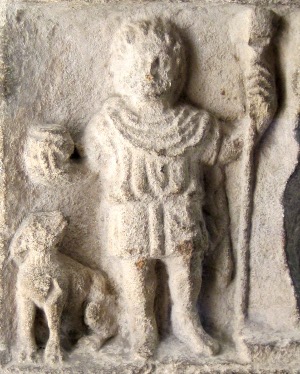
In Gaul we find a god whose iconography is fairly distinct from that of his Italian counterpart. In place of a cypress branch, the god carries a great hammer or mallet. In his other hand he normally carries a kind of large bowl or small pot (called an olla). Still, the two gods present several points in common: both are bearded, mature in age, and surrounded by prosperity symbols.
The hammer is the distinctive emblem of Sucellus (and, as we shall see, of the Silvanus of southern France). His very name, to judge by its Celtic roots, has been taken to mean ‘the good striker’ (the Celtic prefix su- has the same origin as the Greek eu-). What then does Sucellus strike? What is this enormous hammer for? It has been suggested that it symbolizes fence posts (let us not forget that Silvanus protects the boundaries of fields) driven into the ground with a mallet[16] ... or that it is meant to evoke the act of producing or constructing in general ... or else that it incarnates brute force like the hammer of Thor ... or finally that the hammer blows represent thunderclaps or even earthquakes.
The hammer is by no means the only attribute of the god. He very often carries a small cauldron or round pot (an olla) in his right hand. The olla is used to cook and store food, but it can also be used as an urn. It might thus indicate nutritional abundance, or an otherworldly function. P.-M. Duval notes an affinity between Sucellus and Dis Pater,[17] the god of the underworld from whom the Celts claimed descent.[18] (Scholars have sometimes identified Dis Pater with Sucellus, but at other times with Cernunnos. This is one of several points of comparison between the two gods—a point we shall return to below.)
Sucellus has other tools at his disposal: a sickle, a scythe, even a cudgel. In place of the olla, or in addition to it, we find barrels (wine casks?), amphoras, and money-bags.[19] So is the god trespassing on the territory of Liber Pater (Bacchus, the wine god par excellence) or Mercury (the god normally depicted with a money-bag)? Let us not forget that Silvanus’ own domain already includes aspects of fertility and the protection of the fields. Among the Ædui and their neighbours, he seems to have specialized somewhat so as to protect the vineyards that were becoming so important to the region (the future Burgundy).
In fact, a related god can even appear in the same region with no hammer at all. He may bear a goblet, an olla, a barrel, a purse, an amphora, a cornucopia, and/or an offering dish—all symbols of material prosperity, and in particular of prosperity in wine production.[19]
Among other offerings that have not survived, worshippers offered Sucellus miniature hammers or mallets. This tool remains Sucellus’ most distinctive trace. Often (and this is frequently the case in Gallia Narbonensis), a site yields a far greater number of hammers than images of the god himself.
Though Pomona may have turned him down, Silvanus/Sucellus did not remain single in Gaul. His iconography frequently shows him at the side of a queenly goddess whose name—Nantosuelta—is known from the inscription on one Mediomatrican relief (at right). The images of this goddess are concentrated among the Ædui, Lingones and their Belgic neighbours.
Just as Sucellus carries his long-handled hammer, Nantosuelta has her own emblem ... but what it is is debatable. It resembles a little house atop a long staff, a bit like a birdhouse or beehive. Perhaps it is some kind of sceptre. Beyond this, she carries an offering-dish and wears a diadem.
Thanks to the Mediomatrican bas-relief, the name Nantosuelta can be applied to an entire series of depictions of a goddess linked, in most cases, with Sucellus. The goddess may, however, appear on her own, as at Saarburg or Speyer. In both of the latter cases, she is accompanied by a raven; in the first, by a beehive and three honeycomb cells; in the second, by fruits. Cornucopias, (wine?) barrels and amphoras reinforce the symbolism of an abundance of food and drink. All this calls to mind the function of Rosmerta, but the crown that Nantosuelta often wears also offers a parallel with Juno Regina. On one occasion, Nantosuelta even carries the tiller of Fortuna.[20] She reigns, in fine, over the destinies of the have-nots, those who hope for no more than a few simple pleasures (some honey, some wine, and food to eat). The divine couple is often associated with a dog, the animal that is—like themselves—the peasant’s friend and protector.
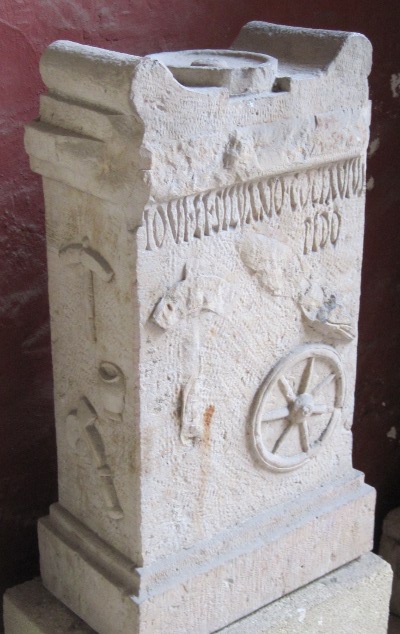
“Silvanus, half-enclosed in a sacred ash-tree,
and supreme guardian of this high garden,
we gratefully dedicate this poem to you
for that (you watch over) us through the fields and Alpine mountains
and among the guests of your fragrant grove,
while I administer the law and carry out the business of the Cæsars
with your protecting favour.
Bring me and mine safely back to Rome
and grant that we may tend the Italian countryside under your guardianship;
then shall I consecrate (to you) a thousand great trees.”
—T. Pomponius Victor, imperial procurator (hymn dedicated at Axima in the Alpes Graiæ)[21]
The hammer-god is as well-known in Gallia Narbonensis (today’s South of France) as in Gallia Comata. Here, however, he is more likely to display attributes typical of the Italian Silvanus ... and he is nearly always called Silvanus. The sole exception is a mention of Sucellus at Vienne, the capital of the Allobroges who are themselves a transitional people at the very border between north and south.[22] Otherwise, the god is specifically Silvanus by name. The northern Sucellus typically wears Gaulish peasant garb—a long, belted tunic—and is bare-headed. In the South of France, as in Italy, Silvanus often wears a crown of leaves; his body may also be nude, though a cape or wolf-pelt may hang from his shoulders or arm. The Gaulish god can still be recognized, however, from his hammer and olla.[23]
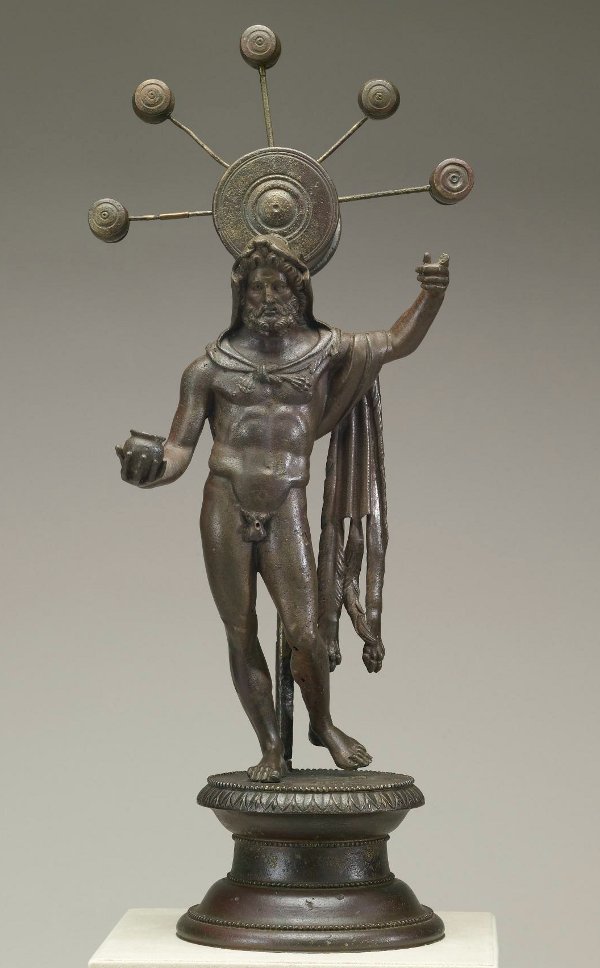
Glanum, Nîmes, and Vaison-la-Romaine are sites where important sanctuaries were dedicated to Silvanus. As many as a hundred altars, carved with a hammer, have been found at the shrine of Silvanus in Glanum. Such altars may also be decorated with pine-cones or (more rarely) a sickle.[24]
In areas where the hammer-god is called Sucellus, we still find inscriptions dedicated to Silvanus. What god do these refer to? Is it the same god (and, if so, why not use the name Sucellus?) or another, perhaps more closely resembling the Italian Silvanus? Let’s first take note that the name Silvanus is substantially in the majority. The hammer-god is named Silvanus across the South, while the name Sucellus is limited to a region stretching from the upper Loire to the Rhine. This is, to be sure, an important part of Gaul, encompassing the Ædui, Lingones, Leuci, and Mediomatrici, but a limited one all the same. The name Silvanus was known across Gaul (notably in Germania Superior and Aquitania). We may as well ask how the Gaulish Silvanus came to preserve his Celtic name at all in some places. Except where circumstances otherwise warrant it, there is no need to ascribe much significance to the use of the name Silvanus in place of Sucellus.
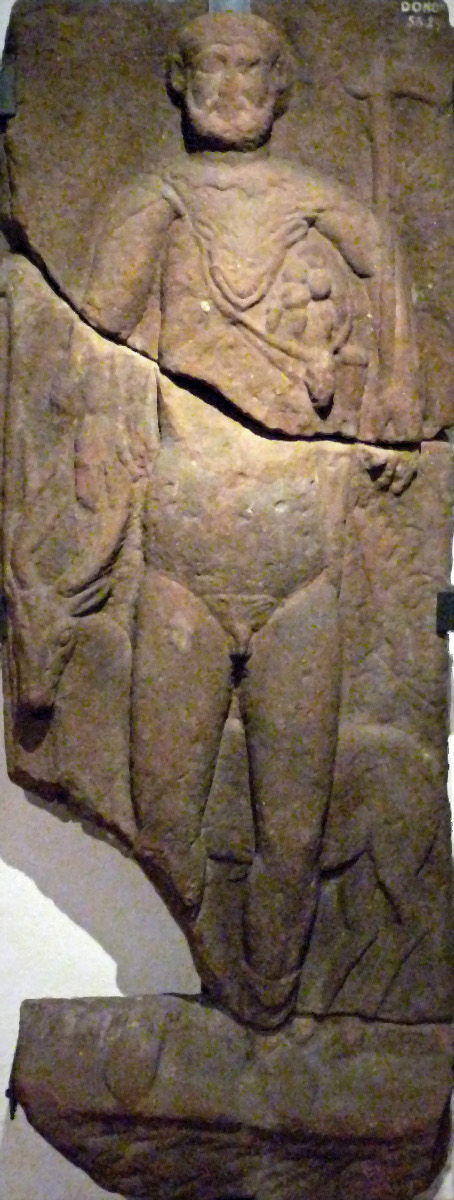
At times, however, Silvanus assumes a peculiar guise which might correspond to an originally distinct deity. For example, we find Vosegus Silvanus in the Vosges in Mediomatrican territory (as well as Vosegus among the Vangiones). At Le Donon, a border shrine in the Vosges—accessible alike to the Mediomatrici, Leuci, and Tribocci—has yielded a depiction of possibly the same god (see left): like Silvanus, he wears a wolf-pelt; he carries on his shoulder a sack filled with almonds and a pinecone; in his left hand he carries a long tool a bit like Sucellus’ hammer, but with a top more like a pick; beside him is a long knife; behind him is a deer, whose antlers the god caresses.[25]
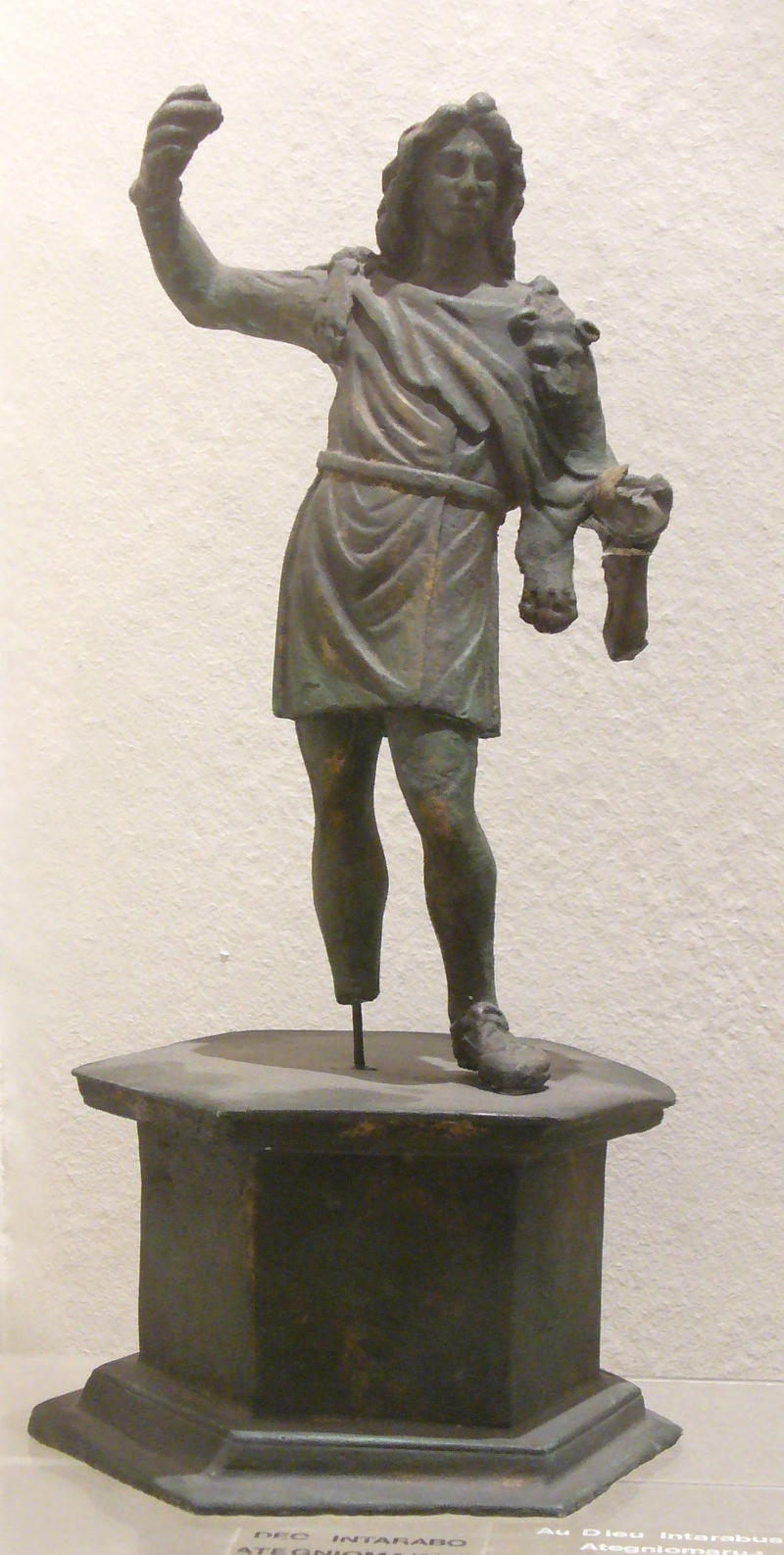
The wolf-pelt attribute is shared in the same region with another god, essentially Treveran, called Intarabus or even Mars Intarabus. The surviving bronze figurine of Intarabus has unfortunately lost its other attributes (Mars’s spear? Sucellus’ hammer?), so we cannot know how much further his iconography resembled that of Silvanus (or, for that matter, of Vosegus!).
Also among the Treveri (at Gérouville), an inscription mentions a god named Silvanus Sinquas (or Sinquatis?). Nearly all that is known about Sinquas is that a Roman citizen fulfilled a vow to him, and that a peregrine did likewise in the interest of his son.[26]
As we have said, Vosegus is depicted with a deer. Another deer-god was also identified with Silvanus, this time in Britain near Hadrian’s Wall in the territory of the Brigantes. The deity in question is Cocidius, a hunter-god worshipped also by this name alone. At Risingham, a relief shows Silvanus Cocidius as a hunter with a hound, a deer, and a tree; on another face of the stone, there is a doe and her fawn under another tree. In addition, a representation at Moresby gives the name Silvanus to an ithyphallic horned god of the Brigantes (who otherwise is normally identified as Mars or Mercury).[27] Does this evidence from the Vosges and Britain show that the antlered god we know as Cernunnos was sometimes called Silvanus? It is possible—the more so as Silvanus seems to have gained popularity in Gaul just as depictions of Cernunnos were disappearing... Still, the story is undoubtedly more complicated. For starters, the hammer-god may have remained essentially distinct, in which case his convergence with the antlered god would be merely incidental.
Other British inscriptions ascribe to Silvanus the epithets Callirius (“hazel-tree god”?) and Vinotonus (“vine god”?).[25]
Friend of the little guy, protector of the countryside, bringer of prosperity to the working man—Silvanus’ basic character does not change. He appears, however, in a variety of forms. The Italian Silvanus is armed with a falx, wears a wolf-pelt, and bears the branch of a tree (typically a pine). In northern Gaul, we find Sucellus/Silvanus with a giant hammer, a rustic tunic, and an olla, together with his faithful dog and sometimes barrels of wine. His depictions in southern Gaul are, if you will, a kind of average of these two types.
The Gaulish Sucellus does not toil alone in his good works; at his side we find Nantosuelta with her regal demeanour. She often shares his attributes, such as amphoras or the dog, no less than his responsibilities. Furthermore, other deities such as Diana, the lares, and the nymphs can be counted as Silvanus’ close companions.
Certain evidence suggests that the worship of Silvanus may in some places disguise that of Cernunnos, which was gradually declined with increasing Romanization. Elsewhere, we find a certain confusion or identification with the Greek Pan and his Roman counterpart Faunus. This by no means diminishes either the originality or the potency of our benevolent hammer-god.
A preliminary draft of this page derives from the article “Silvanus” from William Smith (1867), A Dictionary of Greek and Roman biography and mythology.
fortunatus et ille deos qui nouit agrestis / Panaque Siluanumque senem Nymphasque sorores.Virgil, Georgics II.494-495.
sunt mihi semidei, sunt, rustica numina, nymphae
faunique satyrique et monticolae siluani;
quos quoniam caeli nondum dignamur honore,
quas dedimus, certe terras habitare sinamus.
Siluane sacra semicluse frax[ino]Translation after E. Courtney (1995), Musa Lapidaria: A Selection of Latin Verse Inscriptions, and Bernard Rémy (1998), Inscriptions Latines des Alpes (I.L.Alpes) I: Alpes Graies. The dedicant is obviously a high official of Italian origin, but certain themes here are rather universal: Silvanus’ protection of the countryside, including wild places as well as gardens; his strong association with groves and trees, here including the ash-tree; and the deeply personal connection between the individual worshipper and the god. See also Dorcey (op. cit), p. 58.
et huius alti summe custos hort[uli]
tibi hasce grate dedicamus musicas
quod nos per arua perq(ue) montis Alpicos
tuique luci suaue olentis hospites
dum ius guberno remque fungor Caesarum,
tuo fauore prosperanti sospitas.
Tu me meosque reduces Romam sistito
daque Itala rura te colamus praeside:
ego iam dicabo mil(l)e magnas arbor[es].

